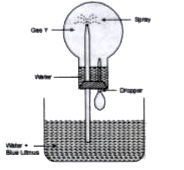Egg membrane used to demonstrate osmosis through thistle funnel experiment acts as
Selectively permeable
Differentially permeable
Permeable
Semipermeable
The correct Answer is:D
To answer the question about the role of the egg membrane in the thistle funnel experiment, we can follow these steps:
1. Understanding the Thistle Funnel Experiment:
- The thistle funnel experiment is designed to demonstrate the process of osmosis, which is the movement of water across a selectively permeable membrane from an area of lower solute concentration to an area of higher solute concentration.
2. Identifying the Role of the Egg Membrane:
- In this experiment, the egg membrane is used to simulate a biological membrane. It is crucial to understand the properties of this membrane to determine its function in osmosis.
3. Defining Membrane Types:
- There are different types of membranes based on their permeability:
- Permeable: Allows all substances to pass through.
- Impermeable: Does not allow any substances to pass through.
- Selectively Permeable: Allows certain substances to pass while blocking others based on size or charge.
- Semi-permeable: Similar to selectively permeable, it allows the passage of small molecules (like water) while preventing larger molecules (like solutes) from passing through.
4. Conclusion:
- The egg membrane acts as a semi-permeable membrane because it allows water to pass through but restricts the movement of larger solute particles. This property is essential for demonstrating osmosis in the experiment.
5. Final Answer:
- Therefore, the correct option is option number four: semi-permeable.
- The thistle funnel experiment is designed to demonstrate the process of osmosis, which is the movement of water across a selectively permeable membrane from an area of lower solute concentration to an area of higher solute concentration.
- In this experiment, the egg membrane is used to simulate a biological membrane. It is crucial to understand the properties of this membrane to determine its function in osmosis.
- There are different types of membranes based on their permeability:
- Permeable: Allows all substances to pass through.
- Impermeable: Does not allow any substances to pass through.
- Selectively Permeable: Allows certain substances to pass while blocking others based on size or charge.
- Semi-permeable: Similar to selectively permeable, it allows the passage of small molecules (like water) while preventing larger molecules (like solutes) from passing through.
- The egg membrane acts as a semi-permeable membrane because it allows water to pass through but restricts the movement of larger solute particles. This property is essential for demonstrating osmosis in the experiment.
- Therefore, the correct option is option number four: semi-permeable.
Topper's Solved these Questions
- TRANSPORT IN PLANTS BOOK - AAKASH SERIESCHAPTER - TRANSPORT IN PLANTS EXERCISE - EXERCISE II
52 Videos
- TRANSPORT IN PLANTS BOOK - AAKASH SERIESCHAPTER - TRANSPORT IN PLANTS EXERCISE - EXERCISE III
20 Videos
- RESPIRATION IN PLANTSBOOK - AAKASH SERIESCHAPTER - RESPIRATION IN PLANTSEXERCISE - Exercise - III
9 Videos
Similar Questions
In thistle funnel experiment
View SolutionAt equilibrium in thistle funnel experiment
View SolutionAt equilibrium in a thistle funnel experiment
View SolutionExperiment demonstrating osmosis
View SolutionIdentify correct statement with regard to thistle funnel experiment
View SolutionIn the phenomenon of osmosis through the semipermeable membrane
View SolutionStudy the figure given aside & answer the questions that follow :
Identify the gas Y.
What property of gas Y does this experiment demonstrate.
Name another gas which has the same property &can be demonstrated through this experiment.
View SolutionStudy the figure given below and answer the questions that follow :

Name another gas which has the same property and can be demonstrated through this experiment.
View SolutionA perfectly semi-permeable membrane when used to separate a solution from its solvent permits through it the passage of
View SolutionWhich experiment is generally used to demonstrate the anomalous expansion of water.
View Solution
